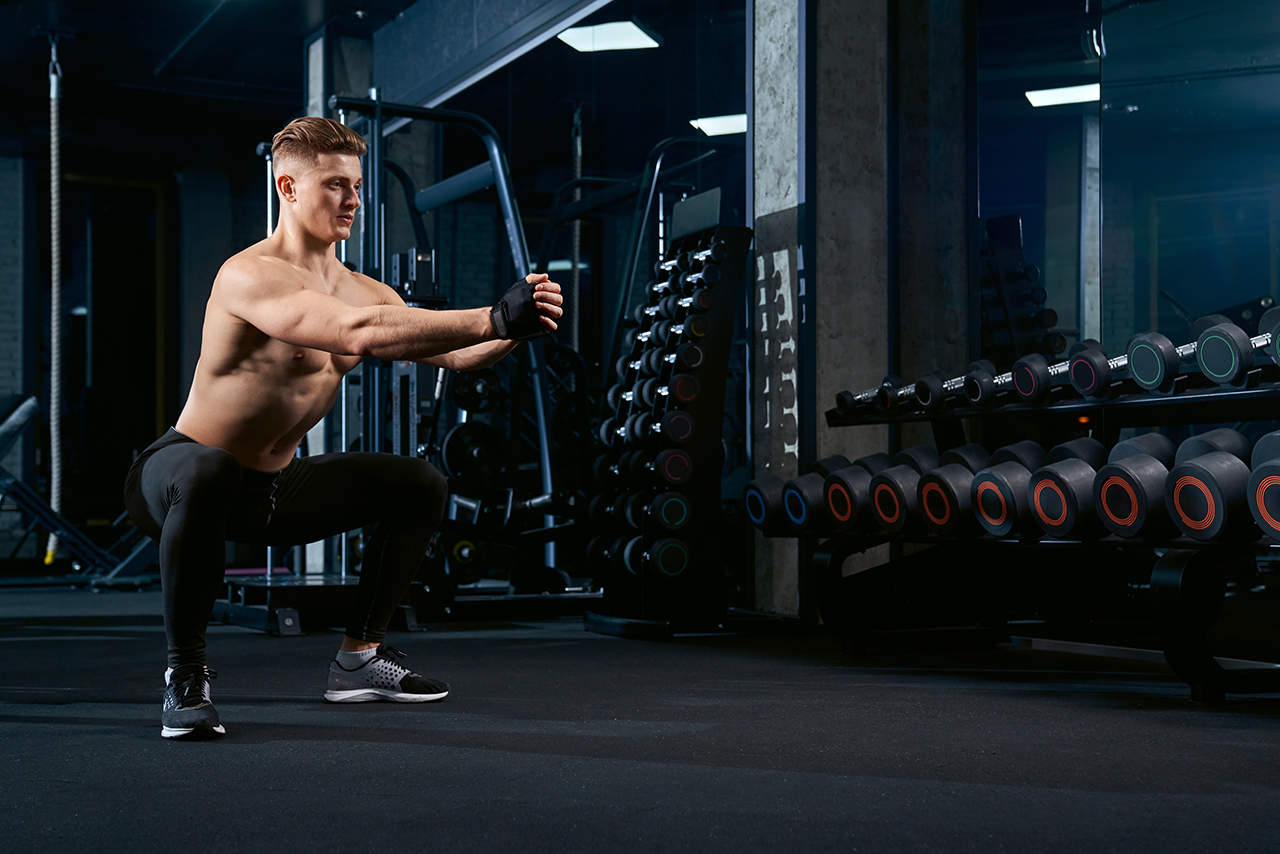Most of the fitness enthusiasts who want to build muscles and strength focus more on their biceps and their thighs but pay less attention to overall body strength compound workouts. But let’s say if you have a busy life schedule and may not have the time to focus on isolated body part workouts, then you may ask which is the single best strength-building exercise.
Truth beholds, if you have done some research or have consulted any exercise scientists, they would have all answered as the squats. The squat is actually a compound workout. Primarily focused on lower-body strength and increases flexibility.
It also trains your core and the back. Squats can strengthen the knees, hips and other joints in general. When doing the squat, flexibility and stability are being engaged to make the hips, knees and ankles work.
We are here to introduce you the true power of squats. The best part is it’s such a simple and effective workout where you can do it at home, office or anywhere convenient enough for you. It doesn’t require a lot of space for you. You don’t have to hit the gym. All you need is your body-weight.
If you are entirely new to squats, then you may need to learn the proper techniques before executing it. Doing the squats can be initially challenging. Squats are not be rushed. We would recommend doing the box squats for beginners. As you keep doing it, pay attention to your form. Sooner or later, you can ditch the box and start with weights.
First things first, we’ll show you the basic proper techniques doing the box to squat. Once you have mastered the body-weight box to squat and no longer find it challenging, you can do it without the box.
Box to Squat
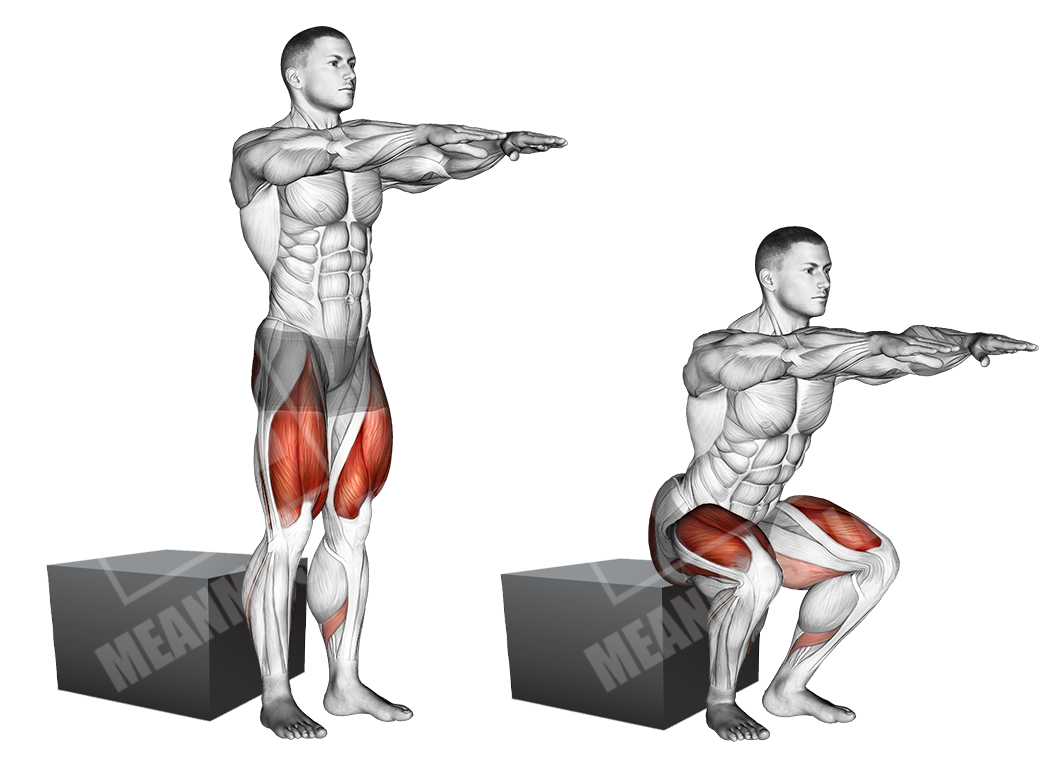
The box to squat primarily targets the gluteal muscles of the buttocks. Other muscle groups involved are the hamstrings, quadriceps (front thigh) and the front shin muscles which support the whole movement. Your core muscles in the abdomen and back extensors are stabilizing your trunk during the movement.
Execution
- With either a box or a bench behind you, step with your feet slightly wider than your shoulder length
- Breathe in deep and out and tighten your core. This will help to stabilize your spine throughout your squat. Keep both your arms clenched near to your chest
- While keeping your core tight, breathe in and slowly go down leaning forward driving your knees out till your butt rests on the box
- Slowly stand up while breathing out back to your starting position. Please maintain a straight back at all times
Note
Here, we are talking about a box to squat workout which is suitable for beginners and also for those who may have joint issues on their knees. You may rest your butt on the box while going down and back standing up.
Whereas a squat to box is where you need to touch your butt on the box acting as a baseline without completely resting on it maintaining some tension. That’s the advanced version of the body-weight squat.
By now your body would have been accustomed to doing body-weight squats and it’s time to push for more challenges. Time to add some resistance to it. The Pulse Squat.
The Pulse Squat
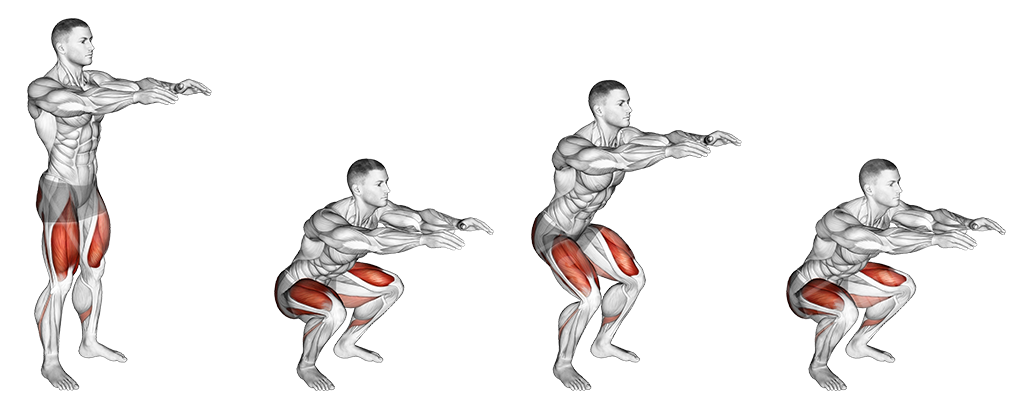
The Pulse squat challenges the glutes, hamstrings and quads and keeps them under constant tension while doing the quick up and down bouncing movement. This helps to build strength and endurance as well as coordination and stability. Your hip mobility improves overall.
Execution
- Place your feet about hip width apart and placing your arms in front of you like a prayer stance, perform a regular squat. Your arms help to stabilize the balance throughout the exercise
- Keeping your chest straight and your head looking forward, go down in to a chair sitting position
- While you are at this position where the resistance is at its most, you will start to do a bouncing chair movement going up and down a little 5 times while keeping your legs and glutes under tension
- Then you slowly go up back to your starting position
Note
The tighter your bounce angle, the higher the tension!
Dumbbell Bench Squat
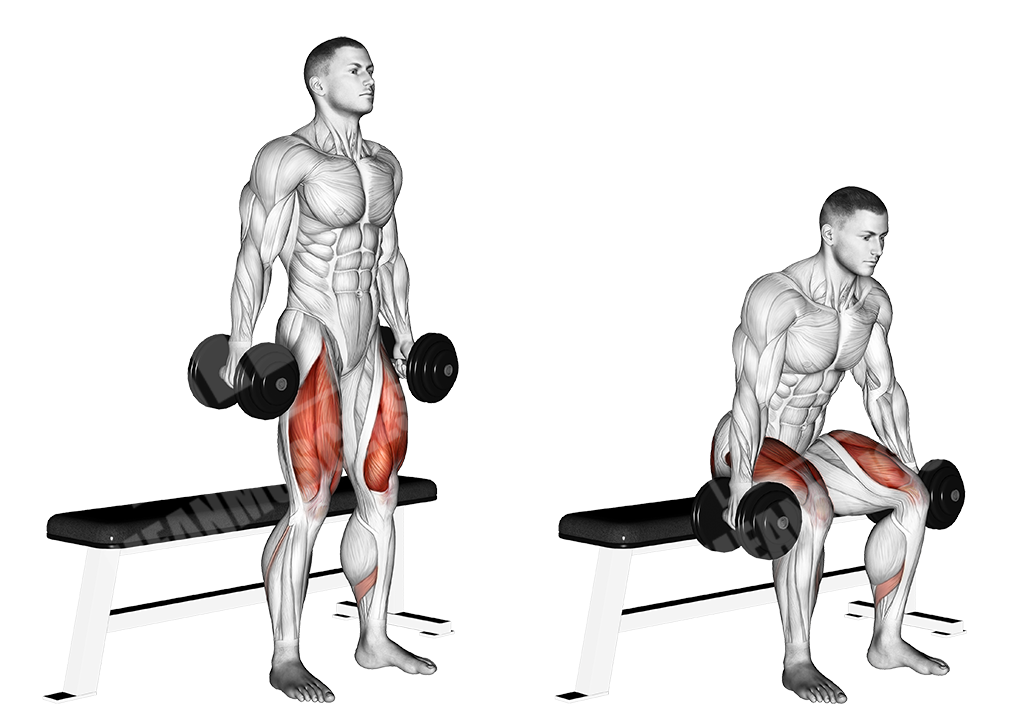
This workout targets the muscles of the thigh and butt but also works the hamstrings and calves. It also targets muscles in your shoulders, upper back, lower back, hips, groin and abs. Dumbbells add more resistance than a traditional body-weight squat, promoting muscle growth.
Execution
- Begin by standing in front of the bench with your knees about shoulder width apart and holding the dumbbells by your side with an over hand grip with your palms facing in
- Make sure you keep your head up and your back straight at all times. Maintaining this posture throughout the workout is very important
- Begin by bending your knees and lower yourself all the way down while inhaling till your glutes touch the bench barely
- Stay in that position for about a second or two and slowly stand up back to your starting position. Much of the pressure should be applied on your heels when you stand up
- Repeat this procedure to your desired number of repetitions
Note
Please do not sit down on the bench completely when you go down as it defeats the purpose of maintaining that tension on your lower body. If you are a beginner, please choose a manageable weight for your dumbbells. Read more about constant tension.
Dumbbell Squat
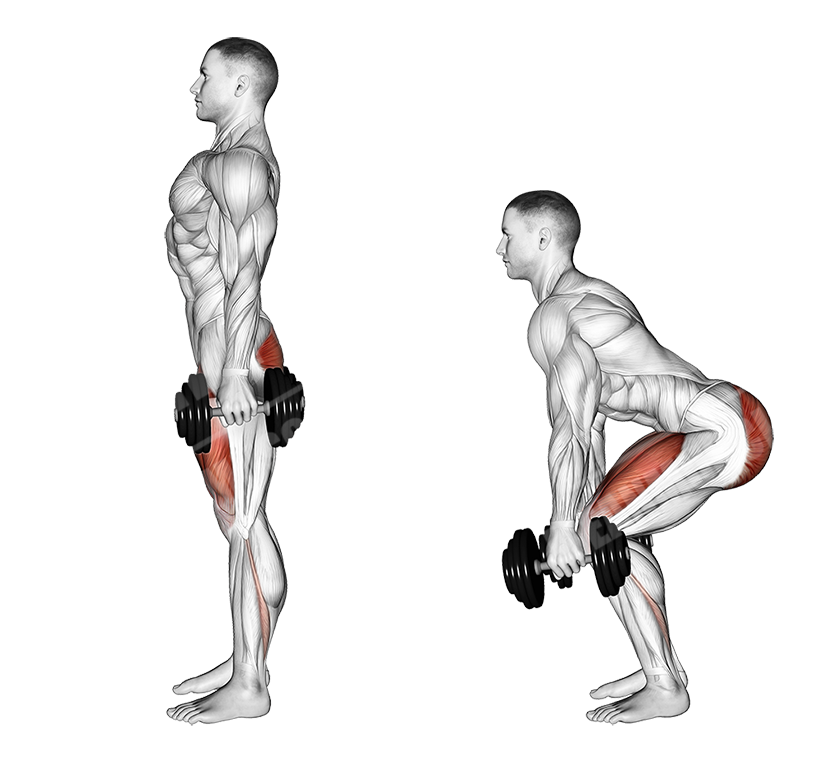
Basically, you are doing this workout without a bench now. They involve the same muscle groups like the bench counterpart. This movement mainly targets the quadricep muscles in the front of your thighs and the gluteus maximus found on the buttocks. Since it’s without the bench, it gives more tension to the muscle groups involved.
Execution
- The starting position should be similar to that of the dumbbell bench squat which we covered earlier. The only difference is that there is no bench now
- Hold the dumbbells in similar position while keeping your head up and your back straight
- Begin by bending your knees slowly until your thighs are parallel to the floor. Make sure that your bent knees are perpendicular to your toes
- Go back to your starting position by standing up slowly applying the pressure off the floor with your heels
- Repeat to your desired number of repetitions
Note
Please do not sit down on the bench completely when you go down as it defeats the purpose of maintaining that tension on your lower body. If you are a beginner, please choose a manageable weight for your dumbbells.
Challenge Yourself
Now that you are more or less used to doing squats both assisted and non-assisted, its time for you to challenge yourself by doing a more challenging type of squat. That’s right. The Bulgarian Spilt Squat.
Bulgarian Split Squat
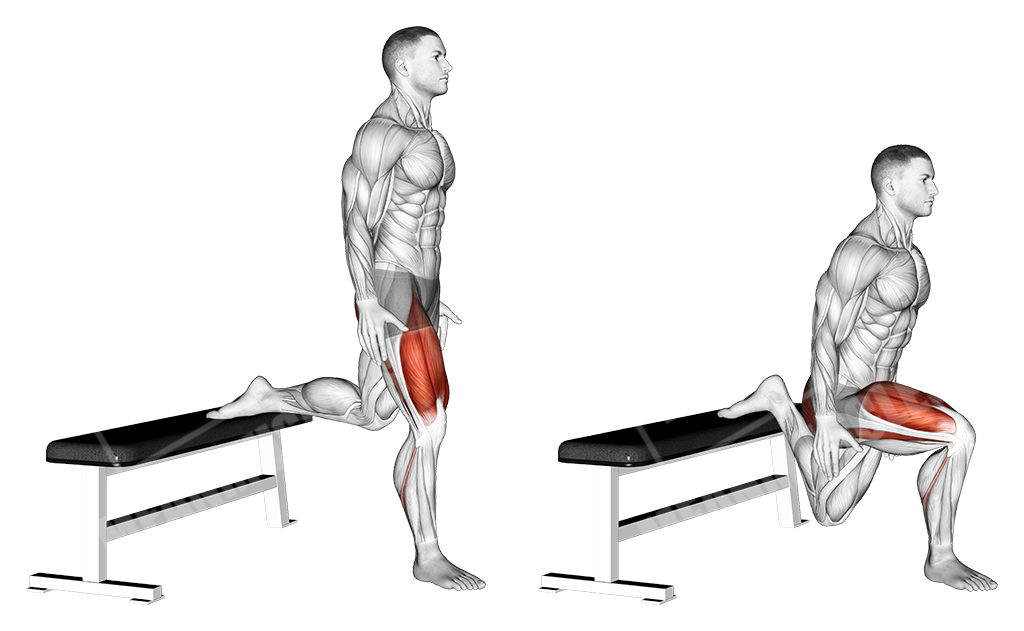
We need to let you know the correct body stance before you start this workout. First you need to address the body distance from the bench. You should not stand too close nor too far away from the bench. Standing too close will put immense pressure on your knees as you go down and if you are too far, it will strain your hip flexors. So, you need to have your foot placement right.
Since this is a single leg workout, your overall body balance will be challenged as you go down. So, to address balancing issue, choose a distant focal point of object for you to observe and make sure when you execute while going down, it stays within your sight. Perform some trials till you get it right.
Muscle groups engaged are the usual suspects in the quads, hamstrings, glutes, and calves. The single leg movement will also force your core to work in overdrive to maintain your balance.
Execution
- Rest your supporting toe somewhere in the middle part of the bench. Keep your head looking ahead at a focal point and your back straight. Keep your arms by your side slightly bent and use them as your tool for the balance needed as you go down
- Start by bending your knee slowly. Make sure your knee should be in line with your pointed toe. It should not exceed
- You are now at the most tensed position. Stay there for a second or two and slowly raise yourself back to your starting position
- Repeat this procedure to your desired number of repetitions
Note
Please use a low bench instead of a high one. High ones tend to make you lose your balance and you might fall forward as you go down. When you go down, your knee should barely touch the floor. Other common mistakes people make is they tend to lean forward as they go down. This can make you go off balance and fall forward leading to possible injuries.
Once you have mastered the spilt squats, you can start adding weights with dumbbells, kettlebells or barbells whichever that you are comfortable with. Interestingly, you can actually use a lightweight dumbbell and hold it near your chest. This will keep you in a more balanced stance throughout as you execute the split squat.
Conclusion
You can notice that our sequence of the squats here always starts with a support to your glutes followed by non-support version. This is to train you to strengthen your legs and balance enough for you to take on the more challenging versions.
There are so many other variations in squats that can engage your entire body muscle groups. Squats basically mimics so many physiological tasks of our daily living. So, the biggest mistake you can make with squats, is to not start squatting.

